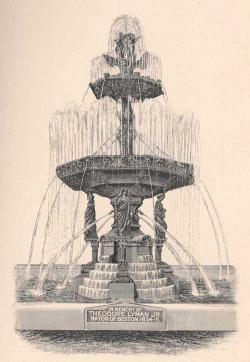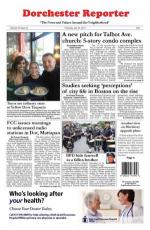February 6, 2014
 A dormant city-owned fountain at the intersection of Bowdoin Street and Adams Street- known as Eaton Square or Coppens Square- replaced an earlier, far more ornate fountain that was erected and names in honor of Mayor Theodore Lyman, Jr.
A dormant city-owned fountain at the intersection of Bowdoin Street and Adams Street- known as Eaton Square or Coppens Square- replaced an earlier, far more ornate fountain that was erected and names in honor of Mayor Theodore Lyman, Jr.
If you drive up the hill on Bowdoin Street from Kane Square, or up Adams Street from Fields Corner, you will arrive at a green in front of First Parish Church and then come to a smaller green in front of the original “This Old House” (the first in the PBS series by that name) and St. Peter’s Church.
I drive by that smaller green nearly every day and wonder why the fountain in the center is never functioning. Are the pipes broken? Is it just neglect from the Parks and Recreation Department? Who is responsible for it?
I would like to get the water flowing and you, the reader, might be able to help.
First, though, did you know that the green originally was named Eaton Square, for Ebenezer Eaton (1787-1874), and that it sits on the site of a former grocery and general store owned by his family, according to a 19th-century history of the town by William Dana Orcutt. More recently, the green was renamed Coppens Square after Rev. Francis X. Coppens, a chaplain who was killed in the Korean War.
The land around the square and up to the top of the hill – where Ronan Park sits – was once part of a large estate called Mt. Ida that was owned by Nahum Capen. It was famous for its grand views of Dorchester Bay, according to the historian Anthony Mitchell Sammarco.
It turns out that this fountain is the smaller of two that have graced the site. The first was called the Lyman Fountain, so named for Theodore Lyman, Jr., the mayor of Boston from 1834 to 1836, and the first Democrat to win that office. It was his idea to introduce a fresh water system into the Boston, and to honor that accomplishment, Nahum Capen commissioned a fountain as a suitable memorial to the far-sighted mayor and sited it in Eaton Square because “I felt that … Eaton Square, in Ward 24, was a sightly and beautiful spot.”
The Lyman Fountain was a tourist attraction in its time, a highly ornamental structure said to be the highest and handsomest fountain in New England. It stood 26 feet tall with a Monson granite foundation that was 36 feet in diameter. At the base of the bronzed iron and zinc pedestal that rose out of the foundation were four figures representing the seasons and holding the first of two pans.
At the top, the fountain was adorned by Venus and Cupid and water was discharged into the air from the mouth of a swan. The water then fell into the highest pan, down through the mouths of four griffins into the second pan and on down through four dragons into the granite below. Water was also forced through 80 jets from the highest pan into the larger pan below and from 144 jets in the lower pan. If that was not enough, water also fell from four cascades at the base. This monument must have been a one-stop Dorchester Disney Land attraction in its time.
What happened to it is a mystery. One theory, according to an account in Sammarco’s book “Dorchester, Then and Now,” is that it was melted down for metals during World War II. Another theory is that it was dismantled and is in some obscure city storage location. One jaded observer thinks it is still sitting there.
The second, smaller fountain that replaced it has been inactive since the 1960s, by most accounts. I would like to see it turned back on. Foot traffic in and around the square would be increased and picnics would be encouraged in this lovely space. Pride in a beautiful public setting improves the morale of a neighborhood and positively impacts property values.
Earl Taylor of the Dorchester Historical Society relates that the city’s Edward I. Browne Fund has been tapped in the last decade to study and make improvements to the green spaces on Meetinghouse Hill, including Eaton-Coppens Square. Taylor says that a report detailed the idea that the fountain could be turned back on – with some common sense safety measures to avoid pooling of water that could be a hazard to children. But the city has not set aside the funds that would be needed to pay for such a restoration. Some of the $75,000 from the Browne Fund has been used to clean and restore another nearby monument to Civil War veterans across from First Parish Church, Taylor said.
I have been in contact with staff of the Boston Parks and Recreation Department who have established a case file that will work its way through engineering and other sections to create a plan and cost out the project. The commissioner, Antonia Pollak, and her staff have been very welcoming of inquiries about the costs of similar projects and are looking into the history of the original fountain. Our district City Councillor, Frank Baker, and our citywide Councillor, Ayanna Pressley, have offered to help.
Now, I ask for reader participation. Are you now, or have you ever been, a resident of Meetinghouse Hill or perhaps an employee of the Parks and Recreation Department? Do you remember seeing the original fountain and, if so, when? Do you know when and/or why it was removed? Do you know what happened to this very large, artistically significant piece of public art? Please contact me at edwardmcook@comcast.net if you can help us move forward. Your thoughts are welcomed and appreciated.
***
Special thanks to Peter Ureneck, another resident of Meeting House Hill, for bringing the mystery of the Lyman fountain to my attention and for his input on the subject, to Earl Taylor of the Dorchester Historical Society and the online Dorchester Atheneum.
Edward M. Cook’s column appears regularly in the Reporter.


